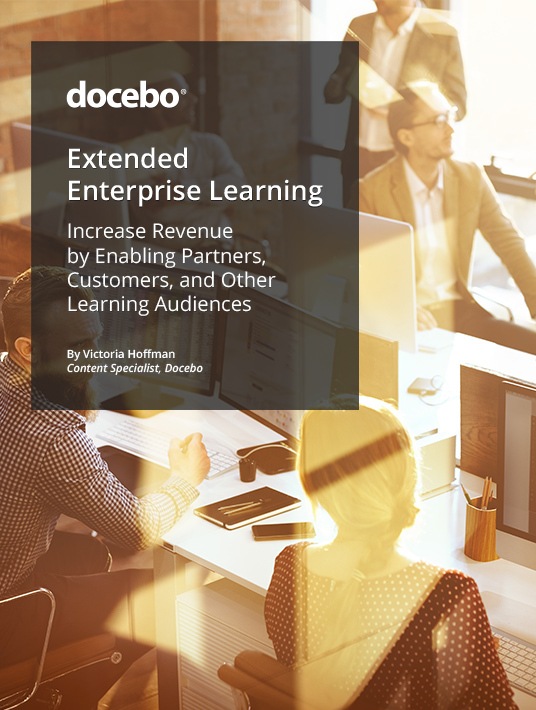How To Get Started With Extended Enterprise Learning
Extended enterprise learning is a training system targeted beyond your organization’s internal employees (e.g., partners, customers, association members, etc.); it could include knowledge sharing, certifications, or performance support provided to your nonemployees such as channel distribution partners, resellers, dealers, franchises, members, customers, and end-users of an organization’s products and services. Before we have a look at how to get started with this remarkable system, let’s explore why creating an active community of partners, customers, and other learning audiences has an incremental impact on your business.

The Benefits Of Extended Enterprise Learning
Organizations who execute effective extended enterprise learning programs can experience many business benefits, including:
1. Increased Revenue
Extended enterprise learning can increase revenue in a few different ways. First, if you’re effectively training channel partners, then their performance will improve, ultimately bringing in more sales for your business. Second, turning training into a profit center by selling training can open up new streams of revenue (or recurring revenue, if sold via subscriptions). Third, if high quality training is offered to customers, they’ll be more likely to renew their contract to your organization’s product and services, allowing your organization to experience less churn
2. Decreased Costs
According to Brandon Hall Group’s Extended Enterprise 2017 survey, 30% of those surveyed say that extended enterprise learning covers more than 50% of the costs of their learning technology. Selling external training can contribute to revenue, while providing external training to customers will increase customer satisfaction and decrease the need for customer support. Similarly, learning technology helps to cut the costs associated with in-person training (travel, instructor costs, etc.).
3. Improved Productivity
Whether extended enterprise learning programs are targeted to customers, partners, or a different learning audience, executing extended enterprise learning using an LMS can help deliver training quickly and effectively. For example, training materials on product updates can be efficiently shared to all audiences, allowing for quicker ramp up, growth, and expansion.
Extended Enterprise Learning In Practice
According to Brandon hall Group’s Extended Enterprise 2017 Survey, the following are the most common objectives of extended enterprise learning:
- Training for new/existing products 69%
- Deliver product or service information 68%
- Compliance training 62%
- Education on specific topics of interest 54%
- Onboarding 48%
- Leadership development 45%
Some examples of extended enterprise learning in practice include:
- Partner channel training and certification.
- Dealer/franchise onboarding/ new product rollout.
- Customer training academy.
- Continuing education.
- Contract workforce compliance.
- Public training.
We hope that by now we have convinced you that extended enterprise learning is an excellent opportunity for your organization to reach multiple audiences. Read on to find out how to launch an extended enterprise strategy.
The Keys To Getting Started With Extended Enterprise Learning
According to John Leh, CEO and Lead Analyst at Talented Learning, getting started with extended enterprise learning involves 3 key pieces: A measurable business case, learning content, and an extended enterprise LMS.
1. Learning Content
Your learning content topics will depend on your extended enterprise audience (customers, partners, or a combination of these). As with internal training, content can be delivered in many different formats and tactics, including webinars, live sessions, social learning, user-generated content, mobile learning, and so on. Whether you choose to create your learning content internally or use a content provider, the learning technology used to deliver the content will have just as much impact on the effectiveness of your extended enterprise learning as the actual content itself
2. Building Your Business Case
You’ll likely have to build a business case to gain executive buy-in in order to:
- Convince your executive team that extended enterprise learning will yield ROI and optimal business outcomes; or
- Convince your executive team to provide the budget necessary to invest in new learning technology that will support extended enterprise learning, or replace your current learning technology with a system that can accommodate your extended enterprise needs.
In order to compose a compelling, data-driven argument, consider including the following when preparing your business case:
- Research outlining the business benefits of extended enterprise programs in similar industries (and for similar use cases).
- An outline of the projected ROI of your extended enterprise project.
- Arguments meant to address each particular executive’s goals, objectives, and potential objections.
- A compelling presentation to guide your executive discussion and agree upon the delivery, management, and measurement of the project.
3. Multiple Audiences, One Extended Enterprise LMS
An extended enterprise LMS is the best way to manage learning for all audiences, both internal and external, as it enables instant delivery of product and service updates to all learning audiences. A Learning Management System can also help to centralize all learning content, as well as manage and target its delivery. More importantly, a state-of-the-art LMS can help make the connection between organizational performance and learning, allowing for more visibility into the link between partner channel performance and the learning content they’ve completed, among other insights.
According to the Brandon Hall Group’s Extended Enterprise 2017 survey, 76% of organizations use a Learning Management System to execute extended enterprise learning. In the same study, 29% of respondents revealed that technology is, to a high degree, the main reason for the effectiveness for their extended learning. 50% of respondents said technology was effective to a medium degree.
To know more on how to increase revenue with extended enterprise learning, download the free eBook Extended Enterprise Learning: Increase Revenue By Enabling Partners, Customers, And Other Learning Audiences.









